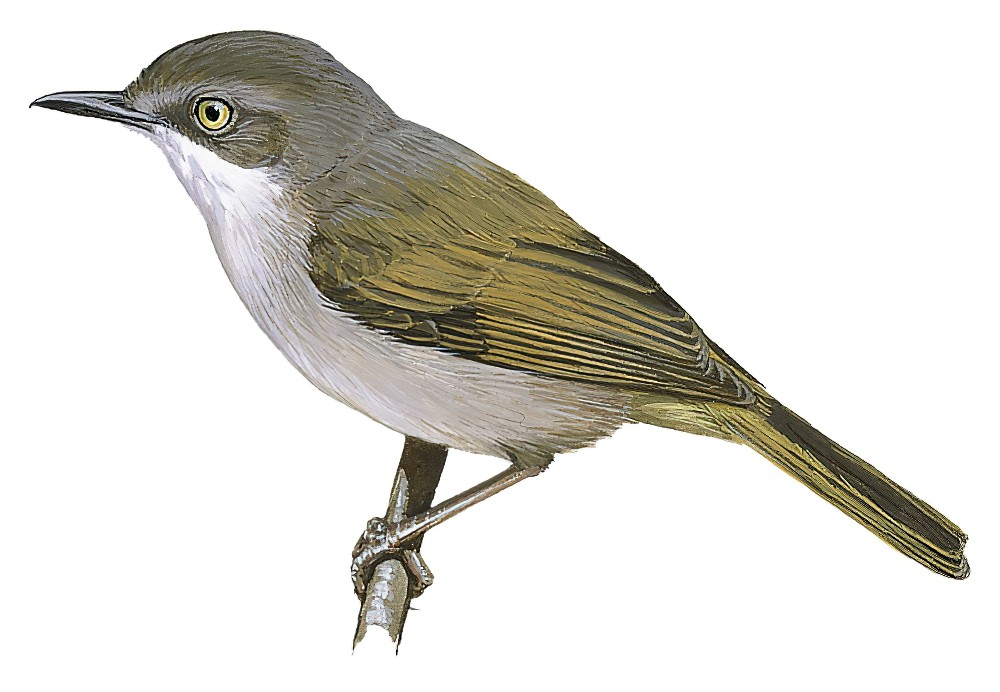Yellow-rumped Eremomela / Eremomela gregalis

Yellow-rumped Eremomela
SCI Name:
Protonym: Malcorus gregalis S.Afr.Comm.Advertiser 4 no.213
Taxonomy: Passeriformes / Cisticolidae / Eremomela
Taxonomy Code: yerere1
Type Locality: northern districts, Little Namaqualand; restricted to Husab, Swakop River, Damaraland, South West Africa, by Clancey, 1969, Durban Mus. Novit., 8, p. 307.
Author: Smith, A
Publish Year: 1829
IUCN Status: Least Concern
DEFINITIONS
EREMOMELA
(Cisticolidae; Ϯ Yellow-bellied Eremomela E. icteropygialis) Gr. ερημος erēmos desert; μελος melos song, melody; "23. Eremomela (n. g.) flaviventris ("Sylvia flaviventris Burch." Wahlb.) in schedulis ... Hab. in Caffraria superiore, campestri et sylvatica. Char. generis. Ala mediocris, vix fornicata, pennis 1—3 gradatis, prima brevi; 3=4. Rostrum subulatum, acutum, vix incisum (fere Sylviæ trochili), vibrissis obsoletis; naribus Sylviæ. Tarsi scutati; digiti laterales æquales. Cauda brevior, leviter emarginata, pennis angustioribus.— Sp. inter Sylvias et Zosteropes mediæ; similes Acanthizis, sed minus pictæ. A Phyllopneustis præcipue differunt vibrissis vix ullis, rostro acutiore, cauda breviore, linea superciliari non distincta, vel saltem non flava. Radices nominis: Eρημος, desertum; μελος, carmen, hinc Eremomela, deserti cantor." (Sundevall 1850); "Eremomela Sundevall, 1850, Öfversigt K. Vetenskaps-Akad. Förhandlingar, Stockholm, 7, p. 102. Type, by original designation, Sylvia flaviventris Burchell [1822 nec Sylvia flaviventris Vieillot, 1817] = Sylvietta icteropygialis Lafresnaye." (Traylor in Peters, 1986, XI, p. 196).
Var. Erenomela.
Synon. Baeoscelis, Dryodromas, Eremomeloides, Magalilais, Tricholais.
gregalis
L. gregalis sociable < grex, gregis herd.
• "Occasionally in pairs, usually in groups of 3-10." (Hockey, Dean & Ryan (eds.) 2005); "Usually seen in small groups." (Peacock 2012) (Eremomela).
• "GEOPELIA HUMERALIS GREGALIS, subsp. nov. ... Similar to Geopelia humeralis humeralis (Temminck) but darker above, especially the hind neck" (Bangs & J. Peters 1926); "Occurs singly, in pairs, groups and congregations which may number dozens of birds." (Coates 1985) (subsp. Geopelia humeralis).
• "It is said to form large flocks that do not mix with other birds, and which move through the paddy fields with a whirring of the wings as they rise and settle." (Restall 1996) (syn. Lonchura malacca jagori).
• "234. F. gregalis N. Terr. Caffror. F. supra fusco-purpurea, subtus vitellina gula nigrescente. Rostrum validum s. d. Plocei Longit. 6" . . . .E. 4 Thls." (Lichtenstein 1823); "In pairs; ♂ and ♀ stay together all year; occurs in family parties of up to 5; does not flock with conspecifics, but joins mixed-species flocks of insectivorous birds" (Fry & Keith (eds.) 2004) (syn. Ploceus bicolor).
SUBSPECIES
Yellow-rumped Eremomela (damarensis)
SCI Name: Eremomela gregalis damarensis
damarensis
Damaraland, Namibia.
Yellow-rumped Eremomela (gregalis)
SCI Name: Eremomela gregalis gregalis
gregalis
L. gregalis sociable < grex, gregis herd.
• "Occasionally in pairs, usually in groups of 3-10." (Hockey, Dean & Ryan (eds.) 2005); "Usually seen in small groups." (Peacock 2012) (Eremomela).
• "GEOPELIA HUMERALIS GREGALIS, subsp. nov. ... Similar to Geopelia humeralis humeralis (Temminck) but darker above, especially the hind neck" (Bangs & J. Peters 1926); "Occurs singly, in pairs, groups and congregations which may number dozens of birds." (Coates 1985) (subsp. Geopelia humeralis).
• "It is said to form large flocks that do not mix with other birds, and which move through the paddy fields with a whirring of the wings as they rise and settle." (Restall 1996) (syn. Lonchura malacca jagori).
• "234. F. gregalis N. Terr. Caffror. F. supra fusco-purpurea, subtus vitellina gula nigrescente. Rostrum validum s. d. Plocei Longit. 6" . . . .E. 4 Thls." (Lichtenstein 1823); "In pairs; ♂ and ♀ stay together all year; occurs in family parties of up to 5; does not flock with conspecifics, but joins mixed-species flocks of insectivorous birds" (Fry & Keith (eds.) 2004) (syn. Ploceus bicolor).
UPPERCASE: current genus
Uppercase first letter: generic synonym
● and ● See: generic homonyms
lowercase: species and subspecies
●: early names, variants, mispellings
‡: extinct
†: type species
Gr.: ancient Greek
L.: Latin
<: derived from
syn: synonym of
/: separates historical and modern geographic names
ex: based on
TL: type locality
OD: original diagnosis (genus) or original description (species)












